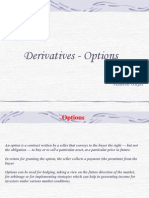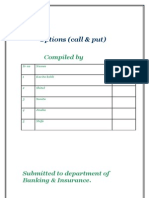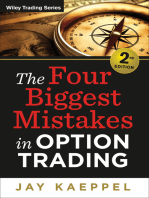Writing Options
Uploaded by
akhileshsingh700Writing Options
Uploaded by
akhileshsingh700WRITING OPTIONS Writing out-of-money options allows you to garner small and consistent returns, during adverse market
conditions. Read on to figure out what these options are and how you can make a quick buck on them WHAT are the chances of SBI touching Rs 780 by the end of this month? Not very bright, you might say.Then, why not write an SBI Rs 780 call option and earn some low risk income? This practice is popularly known as writing out-of-money options. As a result, you can hope to make some decent income in the form of the premium received on writing the option. Writing options First, you must be familiar with option basics. An option can be either out-of-money, in-the-money or at-the-money. A call option is said to be in-the-money if the current market value of the underlying share is above the strike price of the option. Similarly, a put option is said to be in-the-money if the current market value of the underlying asset is below the strike price of the option. For instance, if the current price of Infosys is Rs 2,100, an Infosys 2,000 call option (strike price is Rs 2,000) and Infosys 2200 put option (strike price is Rs 2200) are in-the-money. At-the-money simply means that the current market value of the underlying asset is the same as the strike price. For instance, if the current price of Infosys is Rs 2,100, then Infosys 2100 call and put options (strike price is Rs 2,100) are at-the-money. A call option is said to be out-of-money if the current price of the underlying share is below the strike price of the option. A put option is said to be out-of-money if the current market value of the underlying share is above the strike price of the option. For instance, if the price of Infosys is currently Rs 2,100, then an Infosys 2,200 call option (strike price is Rs 2,200) and Infosys 2,000 put option (strike price is Rs 2,000) are outof-money. Out of money options Logically, you should write a call option when you expect the underlying stock to stay at the same level or fall. Similarly, you could write a put option when you expect the price to stay at the same level or rise. As an option buyer, your risk/ loss is limited to the premium that you have paid. On the other hand, as an option seller, your risk is unlimited whereas your gains are limited to the premiums that you earn. Hence, writing call and put options are considered to be quite risky as the losses can be unlimited, if the value of the underlying asset increases above the exercise price. For instance, if you write or sell one Infosys 1 month at-the-money call option at a strike price of Rs 2,100, when the cash price is also Rs 2,100, you would get a decent premium of anywhere between Rs 50-70. But the risk you would be carrying is quite high. If the price of Infosys rises to more than Rs 2,400 on expiry, then you could stand to lose anywhere between Rs 220-250 per share (Since, the option is cash-settled, the loss will be the cash settlement amount, reduced by the premium). However, it is always less risky to write out-of-money options, as the strike price is
at a premium to the spot price. For instance, if you had written an April call option on SBI at Rs 740, on the March 29, 2005 (when the cash price was Rs 640), you would have received a premium of Rs 5.35 per share.The writer of such options gains because of the erosion of time value of options. As on April 11, 2005, the premium on the same Rs 740 call option falls to Rs 2.45, as the time to maturity narrows down. So, you could just wait till the option matures (at the end of April), hoping that it will expire as worthless. Or, if you feel that would be risky, then you could even square up your position, and earn a net of around Rs 3. In the same manner, if you had written out a Rs 600 April put option on SBI, you would have earned a premium of Rs 7. As on April 11, 2005, the premium on this option was around Rs 3.5. Currently, there is a Rs 780 April call option on SBI, which could earn you a premium of Rs 1.95. Even though you stand to get a much lower premium than you would earn, by writing options quoting nearer the current market price, the risk is also much less, in such options. Many a times, it gets difficult for investors to exit positions that they have built over a period of time. At such times, they could look at selling out of the money call options to hedge themselves and get an additional cushion on the portfolio values. Besides, a study of the options market shows that 80-90 per cent of options expire worthless. Hence, by following the strategy of writing out-of-money options, you can garner small and consistent returns, during adverse market conditions. IN BRIEF An option can be either out-of-money, inthe-money or at-the-money. A call option is said to be out-of-money if the current price of the underlying share is below the strike price of the option. It is always less risky to write out-ofmoney options as the strike price is at a premium to the spot price. The writer of such options gains because of erosion of the time value of options. Although the premium earned on such options is not much, the risk is also low. A study of the options market shows that 80-90 per cent of options expire worthless.
Hi TATrader and sh50, Thanks for starting such a grand topic,which I was also planning to start with. I would like to add a few points to this topic,regarding some of the practical hazards,before one starts buying and selling options. Before playing with options(unlesss suggested by someone else),u really must have a fairly good idea,reading the market movement ,specially the fluctuation of the NIFTY,and the corelation of the particular stock (on which u r planning to play) with the NIFTY movement.Also one must have a fairly good knowledge of the option pricing model,and know how to effectively use the option calculator(very few people actually know it ,with due respect to the senior analysts,and of those few
knowledgeble people,only a handful actually know how to implement the theories into practise in the practical reality;---the misfortune is that these few handful keep this knowledge as a well guarded secret,and never tend to share it ). The first practical hazard that comes into cosideraton is that we tend to forget the brokerage aspect while making all calculations for maximising our profit in option trading.Even though the premium amount involved is small,but the brokerage involved is quite significant.I will give u concrete example. I consider the case of buying NTPC 's 95 CALL to be expired on 31st march'05 at a premium of 2.25per unit(lot size 3250)This is one which I actually traded with.While the total premium amount turns out to be 7312.5, the brokerage (along with all the taxes,effectively .1321% for buying and .1103% for selling, as per my case) turns out to be 417.66(only the buying part).Surprising, forthe newbees,isn't it??? Now we consider some probable cases: The call option price rises to 2.75----Profit Rs. 856(Net brokerage paid Rs. 768) The call option price falls to Rs.1.75---Loss Rs.2389.48(Net brokerage paid Rs.764) Believe my words ,all the newbees---It is the loss which mostly occurs.I am seen it for myself.For the sake of testing ,I saw my entire money getting eroded away--I could have easily got out bearing ab loss of Rs.1200-Rs 1400,but I wanted to feel the pain of losing the wealth ,with an undercurrent false belief that the price would afterall riseand give me profit.(A bit crazy may be,but that's the way it is to learn acc. to my opinion!!I do not sometimes understand how a person like me having a budgeted resource can make such funny decisions!!) Anyway ,the actual reality is that,--option trading is more of a hedging tool(like an insuranse policy),than a trading tool.But I still strongly feel that when we can really come in harmony with the stock market,it can obviously be used as a trading tool,(in fact a intraday trading tool)and can be judiciously utilised for maximising the profit with a very limiited resourse. Dearest TaTrder,(along with Traderji,Creditviolet and all other true knowledgables):given the permission, I can discuss some of the topics of option trading,with ur expert commentry in between all along,and rectifying the mistakes which I'm sure am going to make.I have made a significant researsh in option trading , and I'm ready to share it if the forum wants it.(I actually want to write a book on option trading in the perspective of Indian market,and have just initiated it) But then, their are also a lot of interesting permutations and combinations in the option strategies,which can be only known by experienced traders like u,all. It will be a pleasure and pleviledge for all of us,if we can consider different hypothetical cases and analyse them bit by bit,keeping the theoritical and practical solutions side by side.After all,trading in option is more lke a chess game,where u always have to forsee all the possible moves of the greatest hypothetical player(the stockmarket itself)--- in advance and act accordingly. NB:If u kindly state the proper difference between option buying and selling and calland put option writing ,Iwill be obliged to u. Regards, joy_mitali
You might also like
- NiftyBank Intraday Option Buying Single Successull Strategy78% (9)NiftyBank Intraday Option Buying Single Successull Strategy30 pages
- An Investor's Guide To Trading Options Kindle Version - The OptionsNo ratings yetAn Investor's Guide To Trading Options Kindle Version - The Options6 pages
- Options 101 A Beginner's Guide To Trading Options in The Stock Market by Steve Burns & Holly Burns PDF75% (4)Options 101 A Beginner's Guide To Trading Options in The Stock Market by Steve Burns & Holly Burns PDF42 pages
- On-Line Trading Binary Options (A book for Beginners in Binary Option Trading)From EverandOn-Line Trading Binary Options (A book for Beginners in Binary Option Trading)4.5/5 (6)
- Swing Trading Options 7 Steps Strategy for Beginners to Learn How to Swing Trade in the Financial Marke - 部分3No ratings yetSwing Trading Options 7 Steps Strategy for Beginners to Learn How to Swing Trade in the Financial Marke - 部分35 pages
- An Option Is Part of A Class of Securities Called DerivativesNo ratings yetAn Option Is Part of A Class of Securities Called Derivatives9 pages
- Assignment On: Marter'S of Business Economics (MBE)No ratings yetAssignment On: Marter'S of Business Economics (MBE)19 pages
- Options CA - CS.CMA - MBA: Naveen. RohatgiNo ratings yetOptions CA - CS.CMA - MBA: Naveen. Rohatgi38 pages
- Study Report On Option Trading Strategies in Equity DerivativesNo ratings yetStudy Report On Option Trading Strategies in Equity Derivatives33 pages
- Trading With Weekly Options - Tim HaddockNo ratings yetTrading With Weekly Options - Tim Haddock69 pages
- Derivative Play A Large and Increasingly Important Role in Financial MarketsNo ratings yetDerivative Play A Large and Increasingly Important Role in Financial Markets4 pages
- Trading Long Strangles for Passive Income: A Great Passive Options Trading Strategy: Financial Freedom, #204From EverandTrading Long Strangles for Passive Income: A Great Passive Options Trading Strategy: Financial Freedom, #204No ratings yet
- New Zealand Share Market For Beginners: New Zealand Stock Market GuideFrom EverandNew Zealand Share Market For Beginners: New Zealand Stock Market Guide4/5 (1)
- Verschaeren, Pol - Option Strategies, A Good Investment or A Waste of MoneyNo ratings yetVerschaeren, Pol - Option Strategies, A Good Investment or A Waste of Money22 pages
- Preface: National Institute of Financial Market (NIFMNo ratings yetPreface: National Institute of Financial Market (NIFM65 pages
- Selling Cash-Secured Puts for Passive Income: Financial Freedom, #173From EverandSelling Cash-Secured Puts for Passive Income: Financial Freedom, #173No ratings yet
- Covered Calls vs. Cash-Secured Puts 2: The Best Strategy for Intermediates: Financial Freedom, #284From EverandCovered Calls vs. Cash-Secured Puts 2: The Best Strategy for Intermediates: Financial Freedom, #284No ratings yet
- How To Trade Options: Swing Trading Iron Condors (Exclusive Guide): How To Trade Stock Options, #3From EverandHow To Trade Options: Swing Trading Iron Condors (Exclusive Guide): How To Trade Stock Options, #3No ratings yet
- Italian Stock Market for Beginners Book Mercato azionario per i principianti ItaliaFrom EverandItalian Stock Market for Beginners Book Mercato azionario per i principianti ItaliaNo ratings yet
- Poland Stock Market for Beginners Book: Polish Rynek GiełdowyFrom EverandPoland Stock Market for Beginners Book: Polish Rynek GiełdowyNo ratings yet
- How To Trade Options: Swing Trading Debit Spreads (Exclusive Guide): How To Trade Stock Options, #2From EverandHow To Trade Options: Swing Trading Debit Spreads (Exclusive Guide): How To Trade Stock Options, #2No ratings yet
- How To Trade Options: Swing Trading Credit Spreads (Exclusive Guide): How To Trade Stock OptionsFrom EverandHow To Trade Options: Swing Trading Credit Spreads (Exclusive Guide): How To Trade Stock OptionsNo ratings yet
- Options Trading Strategies - Complete Guide To Getting Started and Making Money With Stock OptionsNo ratings yetOptions Trading Strategies - Complete Guide To Getting Started and Making Money With Stock Options74 pages
- Covered Calls vs. Cash-Secured Puts: The Best Strategy for Beginners: Financial Freedom, #208From EverandCovered Calls vs. Cash-Secured Puts: The Best Strategy for Beginners: Financial Freedom, #208No ratings yet
- (Book - Securities Markets Series) Sunil K. ParameswaraNo ratings yet(Book - Securities Markets Series) Sunil K. Parameswara68 pages



























































